Evolutionary Game Analysis of Abandoned-Bike-Sharing Recycling: Impact of Recycling Subsidy Policy
Abstract
1. Introduction
1.1. Background
- (1)
- How do the recycling subsidy amount and resident satisfaction affect stakeholder decisions?
- (2)
- In order to implement the EPR system nationwide, what subsidy policy should local governments adopt: the fixed-amount recycling subsidy policy or regressive recycling subsidy policy?
- (3)
- Under the policy of regressive recycling subsidies, how can local governments influence stakeholders’ decisions to promote the EPR system?
1.2. Related Literature
1.3. Paper Organization
2. Evolutionary Game Modeling between Local Governments and Bike-Sharing Companies
3. Model Analysis
3.1. Strategy Stability Analysis of Bike-Sharing Companies
- (1)
- If x = (CE2 − CE1)/CE3, then for any y ∈ {0,1}, there is F(y) in the steady state;
- (2)
- If x ≠ (CE2 − CE1)/CE3, then we conduct the following discussion:
- a. Case 1: If (CE2 − CE1)/CE3 < 0 (i.e., CE2 < CE1), then (CE2 − CE1)/CE3 < x ≤ 1, F′(y)|y=0 < 0, F′(y)|y=1 > 0, from which we can conclude that the ESS is y = 0.
- b. Case 2: If 0 < (CE2 − CE1)/CE3 < 1, and if x < (CE2 − CE1)/CE3, then we have F′(y)|y=0 > 0, F′(y)|y=1 < 0, and then the ESS is y = 1; if x > (CE2 − CE1)/CE3, F′(y)|y=0 < 0, F′(y)|y=1 > 0, then the ESS is y = 0.
- c. Case 3: If (CE2 − CE1)/CE3 > 1, then 0 ≤ x ≤ 1,1 < (CE2 − CE1)/CE3. Then, we have F′(y)|y=0 > 0, F′(y)|y=1 < 0, and so the ESS is y = 1.
3.2. Strategy Stability Analysis of Local Governments
- (1)
- If y = (ηδCP − θε)/CE3, then for any x∈{0,1}, there is F(x) in the steady state;
- (2)
- If y ≠ (ηδCP − θε)/CE3, we conduct the following analysis:
- a. Case 4: If ηδCP − θε < 0, then we have 1 ≥ y ≥ (ηδCP − θε)/CE3, F′(x)|x=0 > 0, F′(x)|x=1 < 0. Therefore, the ESS is x = 1. Limited rational local governments will choose the EPR policy to manage the local bike-sharing industry.
- b. Case 5: If 0 < ηδCP − θε ≤ CE3, when 1 ≥ y > (ηδCP − θε)/CE3, F′(x)|x=0 > 0, F′(x)|x=1 < 0, then the ESS is x = 1. When 0 ≤ y < (ηδCP − θε)/CE3, F′(x)|x=0 < 0,F′(x)|x=1 > 0, then the ESS is x = 0.
- c. Case 6: If ηδCP − θε > CE3, then we have y < (ηδCP − θε)/CE3, F′(x)|x=0 < 0, F′(x)|x=1 > 0, and the ESS is x = 0.
4. Analysis and Proof of ESS between Local Governments and Bike-Sharing Companies
4.1. Analysis and Proof of ESS under Fixed Recycling Subsidy Policy
4.1.1. Analysis and Proof of ESS Based on Case 2 and Case 4
4.1.2. Analysis Based on Case 2 and Case 5
4.2. Analysis and Proof of ESS under Regressive Recycling Subsidy Policy
5. Simulation
5.1. Evolutionary Game Analysis under Fixed Recycling Subsidy Policy
5.1.1. Simulation Based on Case 2 and Case 4
- (1)
- Evolutionary simulation of two groups with different initial strategy proportions
- (2)
- Effects of recycling subsidy given by local government
- (3)
- Effects of resident satisfaction
5.1.2. Simulation Based on Case 2 and Case 5
- (1)
- Evolutionary simulation of two groups with different initial strategy proportions
- (2)
- Effects of recycling subsidy given by local government
- (3)
- Effects of resident satisfaction
5.2. Evolutionary Game Analysis under Regressive Recycling Subsidy Policy
- (1)
- Evolutionary simulation of two groups with different initial strategy proportions
- (2)
- Effects of recycling subsidy given by local government
- (3)
- Effects of resident satisfaction
6. Conclusions and Management Implications
- (1)
- When the resident satisfaction is positive, local governments can induce an acceleration of the evolutionary process by increasing the amount of the recycling subsidy. When the resident satisfaction is negative, the impact of the recycling subsidy amount on the evolutionary trajectory decreases. This implies that excessive subsidies will have diminishing marginal effects, which will lead to the inefficient and inflexible use of financial resources. In addition, a threshold effect emerges within the replication dynamic system when a regressive recovery subsidy policy is adopted. When the resident satisfaction exceeds a certain threshold, it will directly lead to a change in the stability point of this system;
- (2)
- The regressive recycling subsidy policy can effectively achieve the nationwide replication of the EPR system. The change in the recycling subsidy policy leads to a fundamental change in the evolutionary trajectory of the replication dynamic system. Under certain conditions, local governments can induce a replication dynamical system without a stability point to transform it into a replication dynamical system with a stability point, and that stability point is E(0,1) (i.e., all local governments implement the EPR system);
- (3)
- Proactive regulation to ensure a high level of resident satisfaction is the basis for local governments to further develop recycling subsidy policies and promote EPR systems. With effective regulation, local governments can effectively promote the EPR system by implementing a regressive recycling subsidy policy, strengthen the environmental responsibility of enterprises, and avoid the “free-rider phenomenon”. In addition, local governments need to control the amount of the recycling subsidy according to local conditions. This is because excessive recycling subsidies may inadvertently not only fail to use financial resources effectively, but also curb the promotion of the EPR system (see Figure 12a).
- (1)
- From the perspective of improving the local environment: Local governments need to take a series of remedial measures to directly correct the current chaos in the bike-sharing industry, such as the huge fines, mandatory recycling, credit records, and reductions in bike size. Moreover, they should plan unified bike-sharing parking spaces, establish a bike-sharing supervision platform, reasonably allocate bike parking lots, and build a long-term supervision mechanism;
- (2)
- From the perspective of setting the recycling subsidy amount: The incentive effect of increasing the amount of recycling subsidies has a marginal decreasing phenomenon, and it is not the case that the higher the amount of recycling subsidies, the better. Therefore, local governments need to set a reasonable amount for recycling subsidies on the basis of the local environment in order to avoid the waste of financial resources;
- (3)
- From the perspective of formulating recycling subsidy policy: The recycling subsidy policy that is negatively related to the promotion of the EPR system is counterintuitive. However, by adopting a regressive recycling subsidy policy, setting reasonable recycling subsidy coefficients, and with effective regulation, it can improve the utilization of financial funds and achieve the green and sustainable development of the bike-sharing industry.
Author Contributions
Funding
Institutional Review Board Statement
Informed Consent Statement
Data Availability Statement
Conflicts of Interest
Appendix A
| Point | Sign(det(J1)) | Sign(tr(J1)) | Result |
|---|---|---|---|
| (0,0) | + | Uncertain | Instability point |
| (0,1) | - | Uncertain | Saddle point |
| (1,0) | + | - | Stability point |
| (1,1) | + | + | Instability point |
| - | 0 | Saddle point |
Appendix B
| Point | Sign(det(J2)) | Sign(tr(J2)) | Result |
|---|---|---|---|
| (0,0) | - | Uncertain | Saddle point |
| (0,1) | - | Uncertain | Saddle point |
| (1,0) | - | Uncertain | Saddle point |
| (1,1) | - | Uncertain | Saddle point |
| + | 0 | Central point |
Appendix C
| Point | Sign(det(J3)) | Sign(tr(J3)) |
|---|---|---|
| (0,0) | ||
| (0,1) | ||
| (1,0) | ||
| (1,1) | ||
| (x*,y*) |
References
- Bullock, C.; Brereton, F.; Bailey, S. The economic contribution of public bike-share to the sustainability and efficient functioning of cities. Sustain. Cities Soc. 2017, 28, 76–87. [Google Scholar] [CrossRef]
- Jca, B.; Dan, Z.; Yue, Z.C.; Bw, D.; Tian, W.E. Life cycle carbon dioxide emissions of bike sharing in china: Production, operation, and recycling. Resour. Conserv. Recycl. 2020, 162, 105011. [Google Scholar]
- Li, T.Z.; Qian, F.; Su, C. Energy consumption and emission of pollutants from electric bicycles. In Advances in Transportation, Pts 1 and 2; Bao, T., Ed.; Trans Tech Publications Ltd.: Stafa-Zurich, Switzerland, 2014; pp. 327–333. [Google Scholar]
- Xinhua. Beijing Launched a Special Action to Share Bicycles, Focusing on the Treatment of the Problem of Concentrated Areas. Available online: https://baijiahao.baidu.com/s?id=1633465777724622982&wfr=spider&for=pc (accessed on 15 May 2019).
- Hunan Daily. Changsha Cleanup and Recycling of Unlicensed Electric Bike Is Effective, but Chaos still Exists with the Bike. Available online: https://hunan.voc.com.cn/article/202011/202011250909068038.html (accessed on 25 November 2020).
- The State Council of China. 2021 Government Work Report. Available online: http://www.gov.cn/guowuyuan/zfgzbg.htm (accessed on 5 March 2021).
- The State Council of China. Extended Producer Responsibility System Implementation Program. Available online: http://www.gov.cn/xinwen/2017-01/03/content_5156100.htm (accessed on 25 December 2016).
- The People’s Government of Sichuan Province. Sichuan Province to Promote the Extended Producer Responsibility System. Available online: https://www.sc.gov.cn/10462/11555/11563/2017/9/14/10433675.shtml?cid=303 (accessed on 6 September 2017).
- Hainan Development and Reform Commission. Hainan Province to Implement the Extended Producer Responsibility System Implementation Plan. Available online: http://plan.hainan.gov.cn/sfgw/0503/202008/a6fc525965f8448d8d3045f754152d28/files/e62803b50d4f443aa6e4aaff01fda629.doc (accessed on 12 August 2020).
- Rubio, S.; Ramos, T.R.P.; Leitão, M.M.R.; Barbosa-Povoa, A.P. Effectiveness of extended producer responsibility policies implementation: The case of Portuguese and Spanish packaging waste systems. J. Clean. Prod. 2019, 210, 217–230. [Google Scholar] [CrossRef]
- Thomas, L.; Reid, L. What’s in a Name: Producer or Product Responsibility? J. Ind. Ecol. 1997, 1, 6–7. [Google Scholar]
- Lai, X.; Sun, Z.; Liu, J.; Wu, G. Resource recycle efficiency improvement analysis for sharing bicycles: Value chain perspective. J. Clean. Prod. 2020, 255, 120284. [Google Scholar] [CrossRef]
- Ren, X.; Herty, M.; Zhao, L. Optimal price and service decisions forsharing platform and coordination between manufacturer and platform with recycling. Comput. Ind. Eng. 2020, 147, 106586. [Google Scholar] [CrossRef]
- Chiariotti, F.; Pielli, C.; Zanella, A.; Zorzi, M. A Bike-sharing Optimization Framework Combining Dynamic Rebalancing and User Incentives. ACM Trans. Auton. Adapt. Syst. 2020, 14, 11. [Google Scholar] [CrossRef]
- Shan, H.; Yang, J. Promoting the implementation of extended producer responsibility systems in china: A behavioral game perspective. J. Clean. Prod. 2019, 250, 119446. [Google Scholar] [CrossRef]
- Zhang, W.; Wang, Z.; Yuan, H.; Xu, P. Investigating the inferior manufacturer’s cooperation with a third party under the energy performance contracting mechanism. J. Clean. Prod. 2020, 272, 122530. [Google Scholar] [CrossRef]
- Wang, L.; Zhao, N.; Liu, D. Complex disaster management: A dynamic game among the government, enterprises, and residents. J. Clean. Prod. 2020, 266, 122091. [Google Scholar] [CrossRef]
- Wang, Z.; Zheng, L.; Zhao, T.; Tian, J. Mitigation strategies foroveruse of chinese bikesharing systems based on game theory analyses of three generations worldwide. J. Clean. Prod. 2019, 227, 447–456. [Google Scholar] [CrossRef]
- Yu, M.; Li, Q.; Wu, Z. Multi-player Game Model and Mixed Strategy Analysis in Sharing System. In Proceedings of the 2019 IEEE Symposium on Product Compliance Engineering—Asia (ISPCE-CN), Hong Kong, China, 23–26 October 2019. [Google Scholar]
- Zhang, L.; Long, R.; Huang, Z.; Li, W.; Wei, J. Evolutionary game analysis on the implementation of subsidy policy for sustainable transportation dev-elopment. J. Clean. Prod. 2020, 267, 122159. [Google Scholar] [CrossRef]
- Wang, Z.; Huo, J.; Duan, Y. The impact of government incentives and penalties on willingness to recycle plastic waste: An evolutionary game theory perspective. Front. Environ. Sci. Eng. 2020, 14, 29. [Google Scholar] [CrossRef]
- Cui, H.; Wang, R.; Wang, H. An evolutionary analysis of green finance sustainability based on multi-agent game. J. Clean. Prod. 2020, 269, 121799. [Google Scholar] [CrossRef]
- Ma, L.; Zhang, L. Evolutionary game analysis of construction waste re-cycling management in china. Resour. Conserv. Recycl. 2020, 161, 104863. [Google Scholar] [CrossRef]
- Ji, S.F.; Zhao, D.; Luo, R.J. Evolutionary game analysis on local governments and manufacturers’ behavioral strategies: Impact of phasing out subsidies for new energy vehicles. Energy 2019, 189, 116064. [Google Scholar] [CrossRef]
- Wang, X.; He, Q.L.; Ji, Q. Evolutionary dynamics of consumers’ crowdfunding strategies based on replicator dynamics. Syst. Eng. Eory Pract. 2017, 37, 2812–2820. [Google Scholar]
- Cui, R.Y.; Hultman, N.; Cui, D.; Mcjeon, H.; Zhu, M. A plant-by-plant strategy for high-ambition coal power phaseout in china. Nat. Commun. 2021, 12, 1468. [Google Scholar] [CrossRef] [PubMed]
- Weibull, J.W. Evolutionary Game Theory (Paper); MIT Press: Cambridge, MA, USA, 2009; Available online: https://econpapers.repec.org/bookchap/mtptitles/0262731215.htm (accessed on 12 November 2022).
- Zhang, Y.; Mi, Z. Environmental benefits of bike sharing: A big data-based analysis. Appl. Energy 2018, 220, 296–301. [Google Scholar] [CrossRef]
- Cheng, B.; Li, J.; Su, H.; Lu, K.; Chen, H.; Huang, J. Life cycle assessment of greenhouse gas emission reduction through bike-sharing for sustainable cities. Sustain. Energy Technol. Assess. 2022, 53, 102789. [Google Scholar] [CrossRef]
- Zhu, M.; Hu, X.; Lin, Z.; Li, J.; Wang, C. Intention to adopt bicycle-sharing in China: Introducing environmental concern into the theory of planned behavior model. Environ. Sci. Pollut. Res. 2020, 27, 41740–41750. [Google Scholar] [CrossRef] [PubMed]
- Chen, Y.; Sun, X.; Deveci, M.; Coffman, D.M. The impact of the COVID-19 pandemic on the behaviour of bike sharing users. Sustain. Cities Soc. 2022, 84, 104003. [Google Scholar] [CrossRef]
- Belk, R.W.; Eckhardt, G.M.; Bardhi, F. (Eds.) Handbook of the Sharing Economy; Edward Elgar Publishing: Cheltenham, UK, 2019. [Google Scholar]
- Cheng, X.; Long, R.; Chen, H.; Yang, J. Does social interaction have an impact on residents’ sustainable lifestyle decisions? A multi-agent stimulation based on regret and game theory. Appl. Energy 2019, 251, 113366. [Google Scholar] [CrossRef]
- Si, H.; Su, Y.; Wu, G.; Liu, B.; Zhao, X. Understanding bike-sharing users’ willingness to participate in repairing damaged bicycles: Evidence from china. Transp. Res. Part A Policy Pract. 2020, 141, 203–220. [Google Scholar] [CrossRef]
- Ye, X. Bike-Sharing Adoption in Cross-National Contexts: An Empirical Research on the Factors Affecting Users’ Intentions. Sustainability 2022, 14, 3208. [Google Scholar] [CrossRef]
- Kavurmacioglu, E.; Alanyali, M.; Starobinski, D. Competition in private commons: Price war or market sharing? IEEE/ACM Trans. Netw. 2016, 24, 29–42. [Google Scholar] [CrossRef]
- Meng, Q.; Chu, L.; Li, Z.; Chen, J.; Wu, C. Cooperation performance of multi-organisations operating in a sharing economy: Game theory with agent-based modelling. Int. J. Prod. Res. 2019, 48, 1–14. [Google Scholar] [CrossRef]
- Jiang, Z.; Lei, C.; Ouyang, Y.; Mannering, F. Optimal investment and management of shared bikes in a competitive market. Transp. Res. Part B Methodol. 2020, 135, 143–155. [Google Scholar] [CrossRef]
- Wang, Y.; Sun, S. Does large scale free-floating bike sharing really improve the sustainability of urban transportation? Empirical evidence from Beijing. Sustain. Cities Soc. 2022, 76, 103533. [Google Scholar] [CrossRef]
- Federico, C.; Chiara, P.; Andrea, Z.; Michele, Z. A dynamic approach to rebalancing bike-sharing systems. Sensors 2018, 18, 512. [Google Scholar]
- Hotelling, H. The economics of exhaustible resources. Bull. Math. Biol. 1931, 53, 281–312. [Google Scholar] [CrossRef]
- Björnerstedt, J.; Weibull, J.W. Nash Equilibrium and Evolution by Imitation (No. 407); IUI Working Paper; 1994; Available online: https://econpapers.repec.org/paper/hhsiuiwop/0407.htm (accessed on 12 November 2022).
- Dufwenberg, M.; Guth, W. Indirect evolution vs. strategic delegation:a c-omparison of two approaches to explaining economic institutions. Eur. J. Political Econ. 1999, 15, 281–295. [Google Scholar] [CrossRef]
- Huck, S.; Oechssler, J. The indirect evolutionary approach to explaining fair allocations. Games Econ. Behav. 1999, 28, 13–24. [Google Scholar] [CrossRef]
- Quijano, N.; Ocampo-Martinez, C.; Barreiro-Gomez, J.; Obando, G.; Pantoja, A.; Mojica-Nava, E. The role of population games and evolutionary dynamics in distributed control systems: The advantages of evolutionary game theory. IEEE Control Syst. 2017, 37, 70–97. [Google Scholar]
- Hotelling, H. Stability in Competition. In The Collected Economics Articles of Harold Hotelling; Darnell, A.C., Ed.; Springer: New York, NY, USA, 1990. [Google Scholar]
- O’Hare, M. Not on my Block You Don’t: Facility siting and the strategic importance of compensation. Public Policy 1977, 25, 407–458. [Google Scholar]
- McCrea, R.; Shyy, T.K.; Stimson, R.J. Satisfied residents in different types of local areas: Measuring what’s most important. Soc. Indic. Res. 2014, 118, 87–101. [Google Scholar] [CrossRef]
- Konzelmann, S.; Fovargue-Davies, M.; Schnyder, G. The faces of liberalcapitalism: Anglo-saxon banking systems in crisis? Camb. J. Econ. 2012, 36, 495–524. [Google Scholar] [CrossRef]
- Amable, B. The Diversity of Modern Capitalism; Oxford Academic: Oxford, UK, 2003. [Google Scholar]
- Bátiz–Lazo, B.; Locke, R.R.; Müller, K. The future of rhineland capitalismacross the polish-german border. J. Manag. Hist. 2013, 14, 12–22. [Google Scholar]
- Report of Market Prospective and Investment Strategy Planning on China Shared Bicycle Industry (2021–2026). Available online: https://bg.qianzhan.com/report/detail/1703231703145753.html (accessed on 31 March 2021).
- Mouratidis, K.; Ettema, D.; Nss, P. Urban form, travel behavior, and travel satisfaction. Transp. Res. Part A Policy Pract. 2019, 129, 306–320. [Google Scholar] [CrossRef]
- National Development and Reform Commission. Opinions on Further Strengthening the Management of Plastic Pollution. Available online: https://www.ndrc.gov.cn/xxgk/zcfb/tz/202001/t20200119_1219275.html (accessed on 3 January 2017).
- Zhou, W.; Zheng, Y.; Huang, W. Competitive advantage of qualified weee recyclers through epr legislation. Eur. J. Oper. Res. 2017, 257, 641–655. [Google Scholar] [CrossRef]
- Mao, M.; Bao, Z.; Tang, Y.; Qin, H.; Ai, M. Recycling and repair strategies of fault sharing bicycles. Comput. Integr. Manuf. Syst. 2022, 28, 3967. (In Chinese) [Google Scholar]
- Si, H.; Shi, J.; Wu, G.; Wang, H. The evolution of Multi-agent Game in Recycling of Waste Bike Sharing. J. Beijing Inst. Technol. 2020, 22, 13. (In Chinese) [Google Scholar] [CrossRef]
- Beijing Municipal Commission of Transport. Technical and Service Specifications for Bike Sharing Systems. Available online: http://jtw.beijing.gov.cn/xxgk/tzgg/201709/t20170921_1279546.html (accessed on 19 September 2017).
- Beijing Municipal Commission of Transport. On the Internet Rental Bicycle Industry in the First Quarter of 2020 Operation and Management Supervision. Available online: http://jtw.beijing.gov.cn/xxgk/tzgg/202005/t20200527_1909462.html (accessed on 27 May 2020).
- Beijing Municipal Commission of Transport. About the Internet Rental Bicycle Industry in 2020 Operation Regulation and 2021 Vehicle Launch Scale. Available online: http://jtw.beijing.gov.cn/xxgk/tzgg/202104/t20210413_2354015.html (accessed on 13 April 2021).
- Beijing Municipal Commission of Transport. Transportation Administrative Penalties List. Available online: http://jtw.beijing.gov.cn/xxgk/tzgg/201709/t20170920_1279545.html (accessed on 20 September 2017).
- Mao, G.; Hou, T.; Liu, X.; Zuo, J.; Sandhu, S. How can bicycle-sharing have a sustainable future? a research based on life cycle assessment. J. Clean. Prod. 2020, 282, 125081. [Google Scholar] [CrossRef]
- Yuan, T.; Yang, Y. Sustainable e-bike sharing recycling supplier selection: An interval-valued pythagorean fuzzy magdm method based on preference information technology. J. Clean. Prod. 2020, 287, 125530. [Google Scholar]
- Liu, D.; Xiao, X.; Li, H.; Wang, W. Historical evolution and benefit-cost explanation of periodical fluctuation in coal mine safety supervision: An evolutionary game analysis framework. Eur. J. Oper. Res. 2015, 243, 974–984. [Google Scholar] [CrossRef]
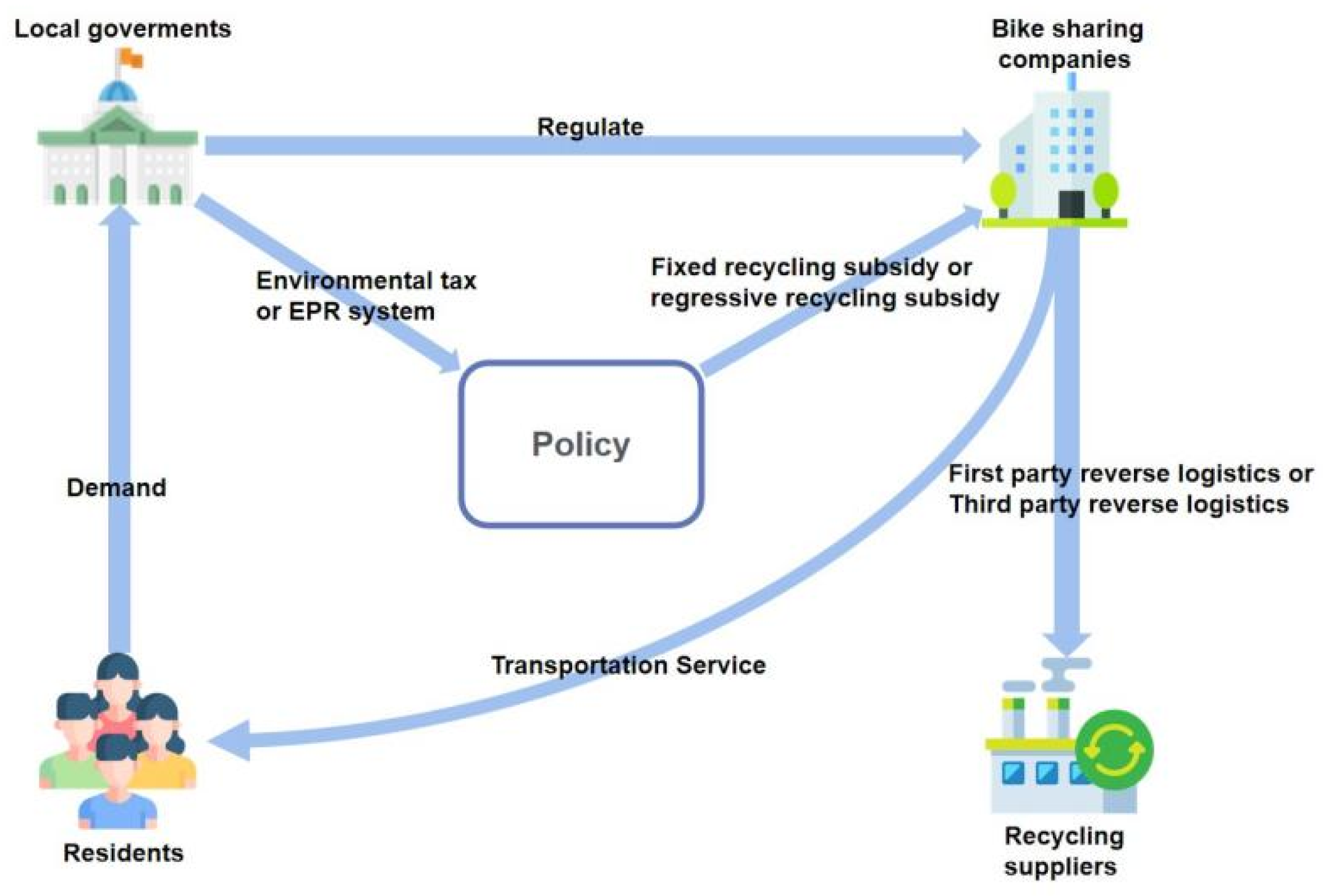
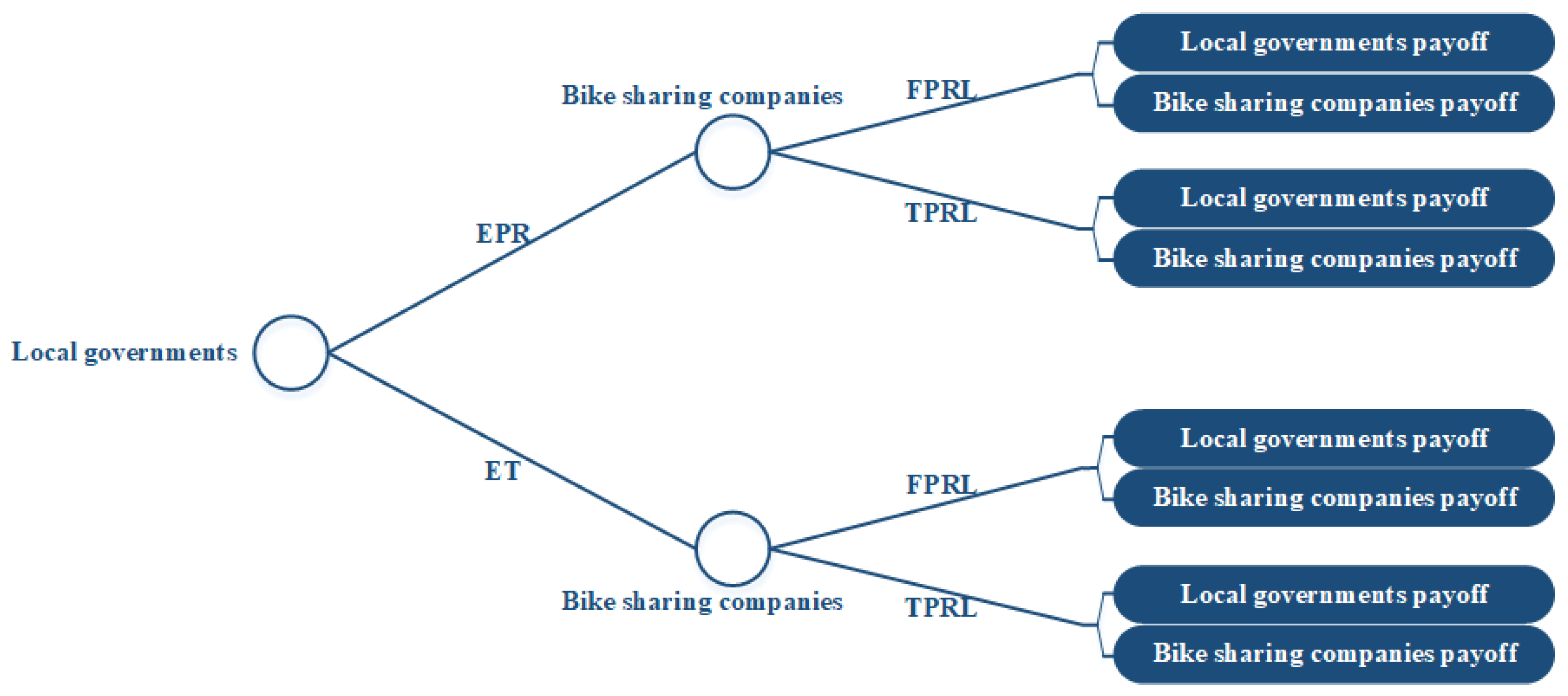



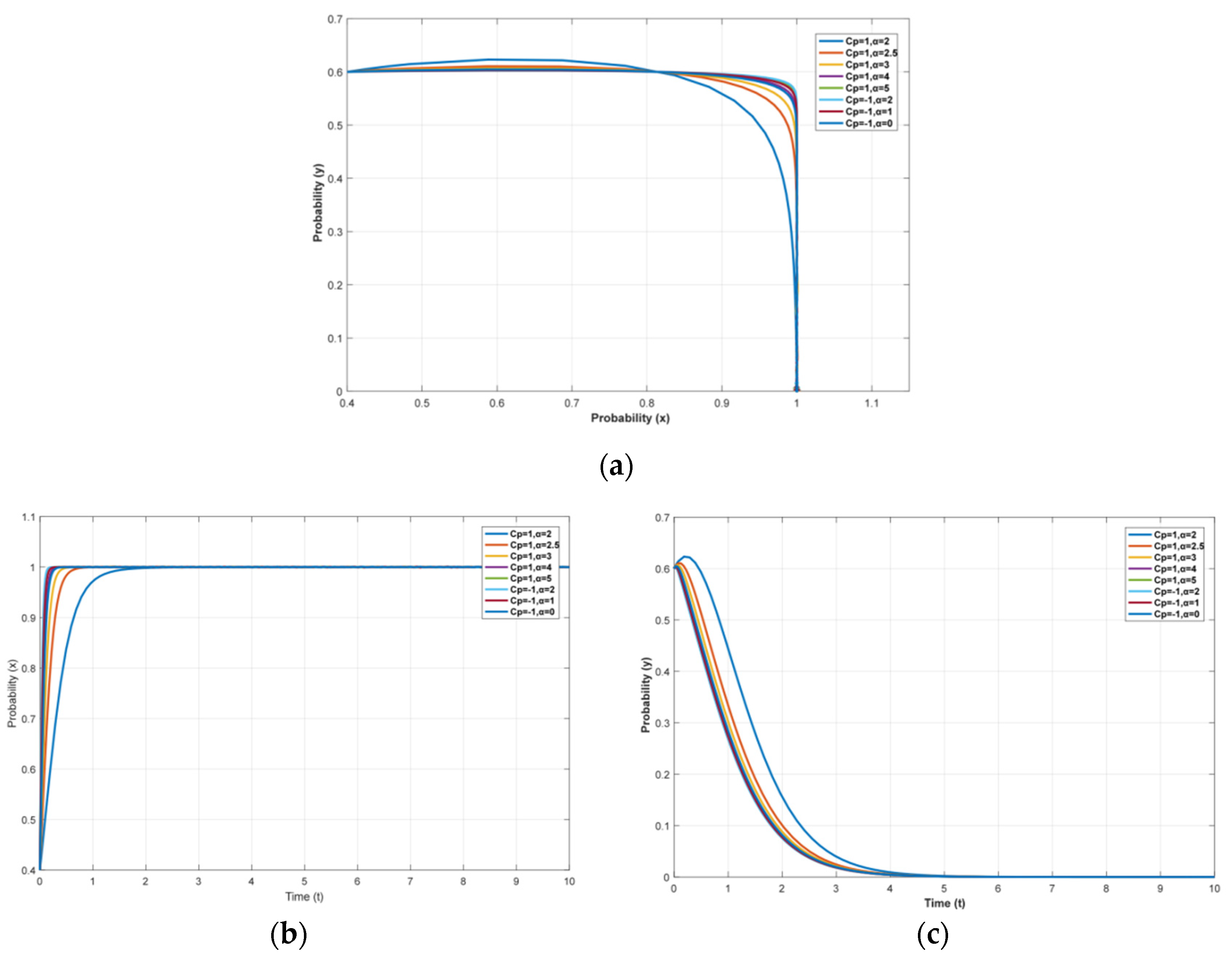

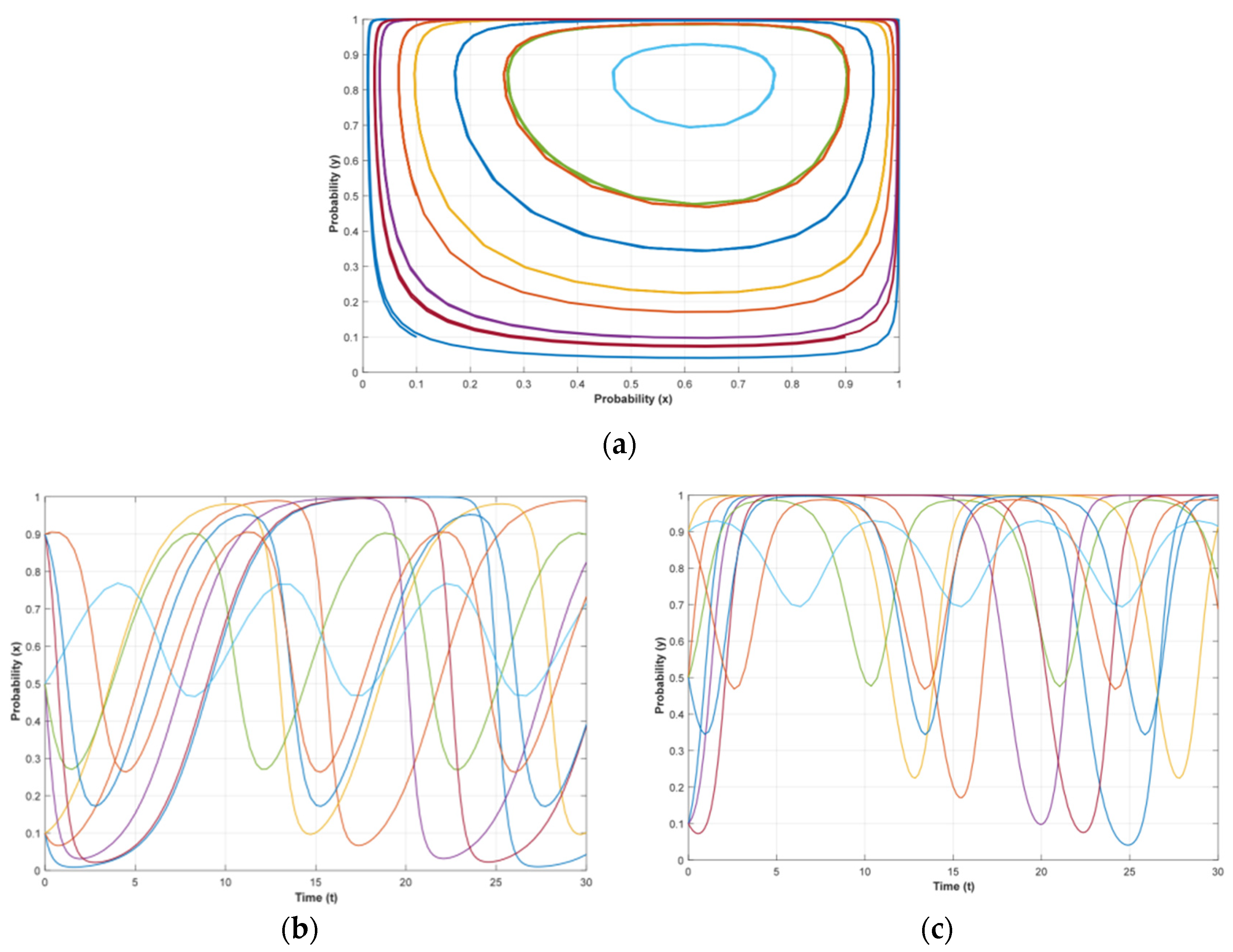
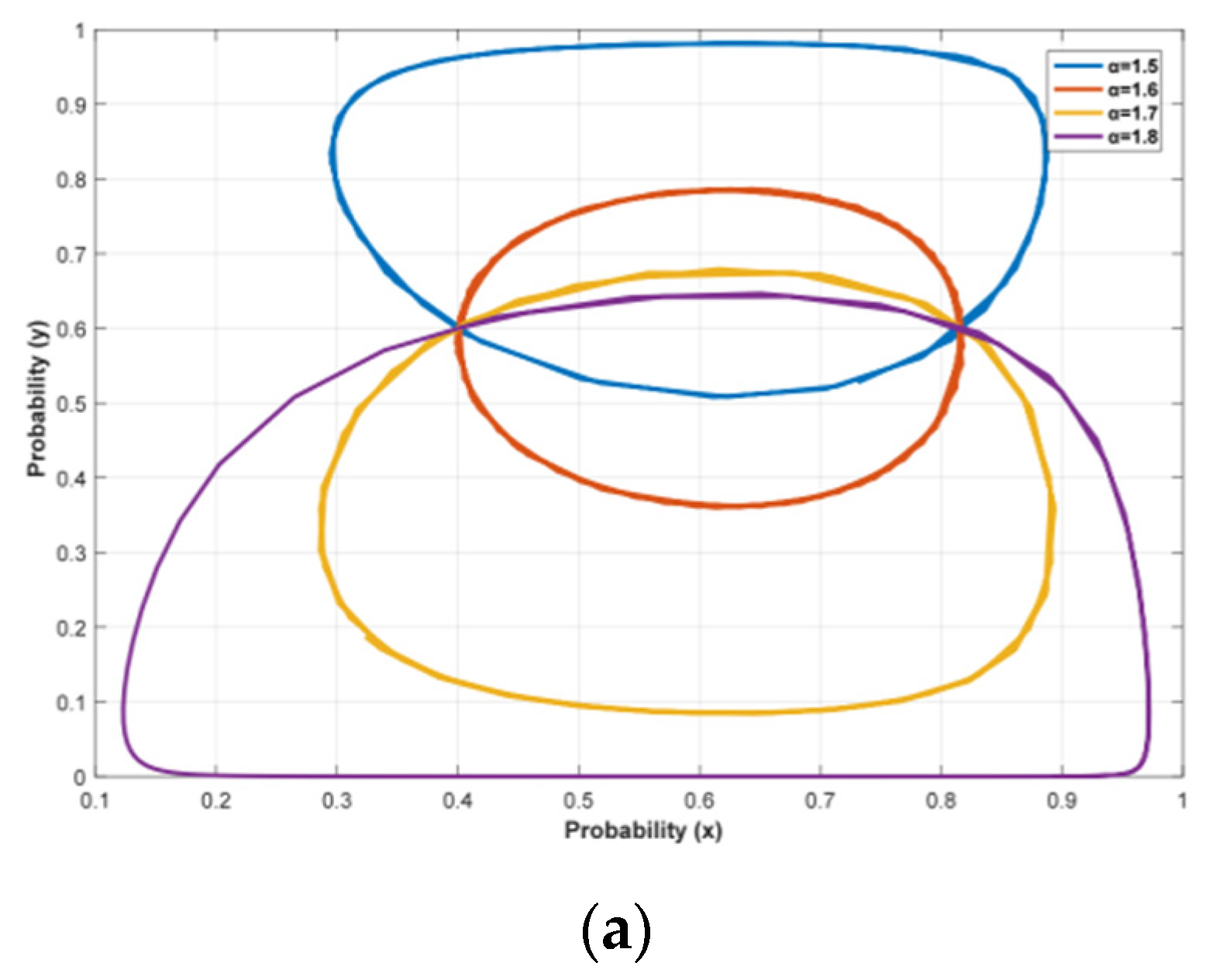
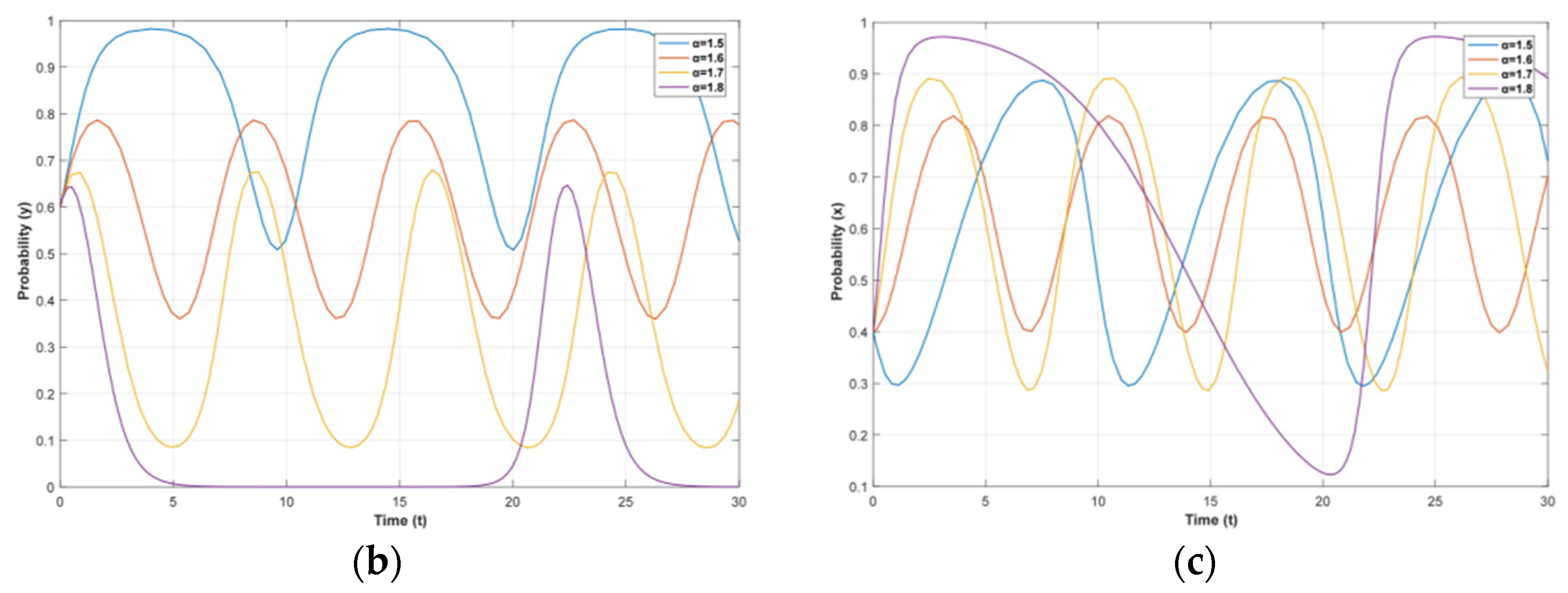


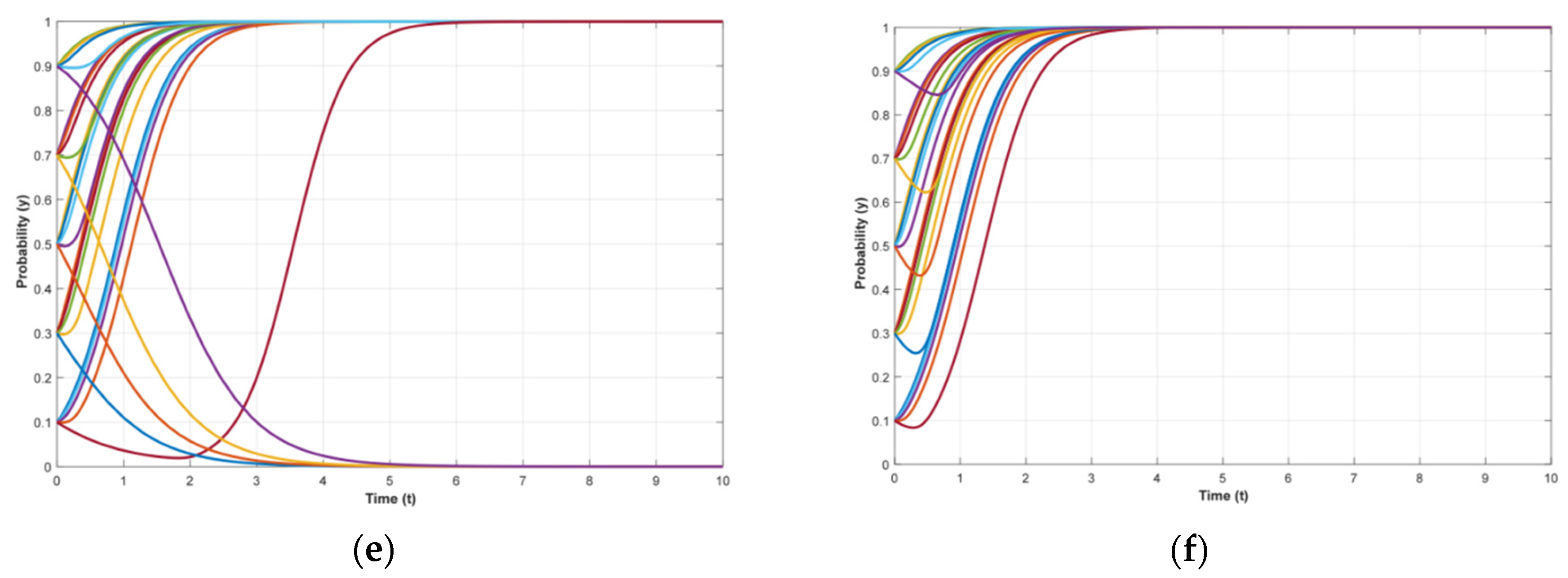
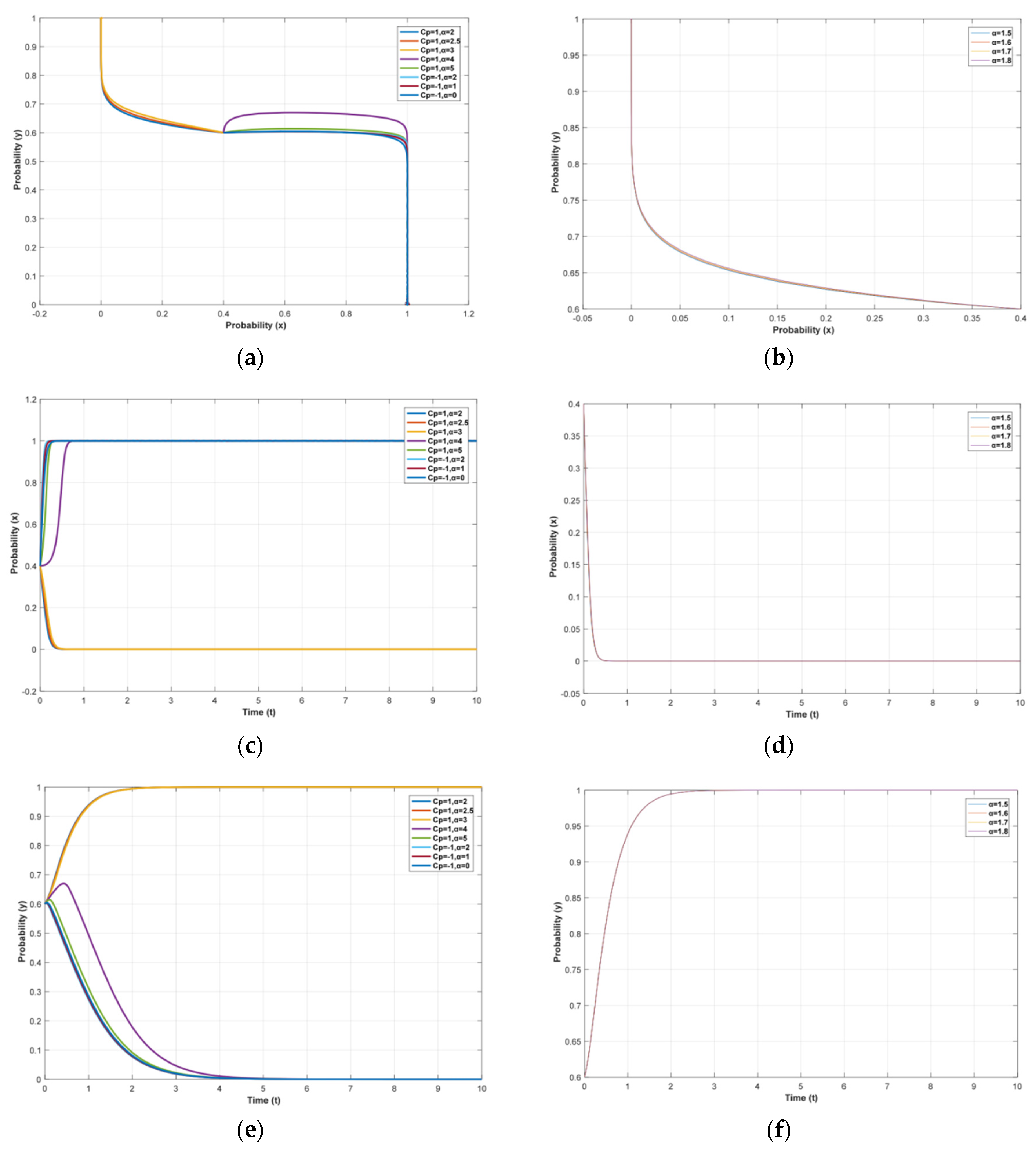

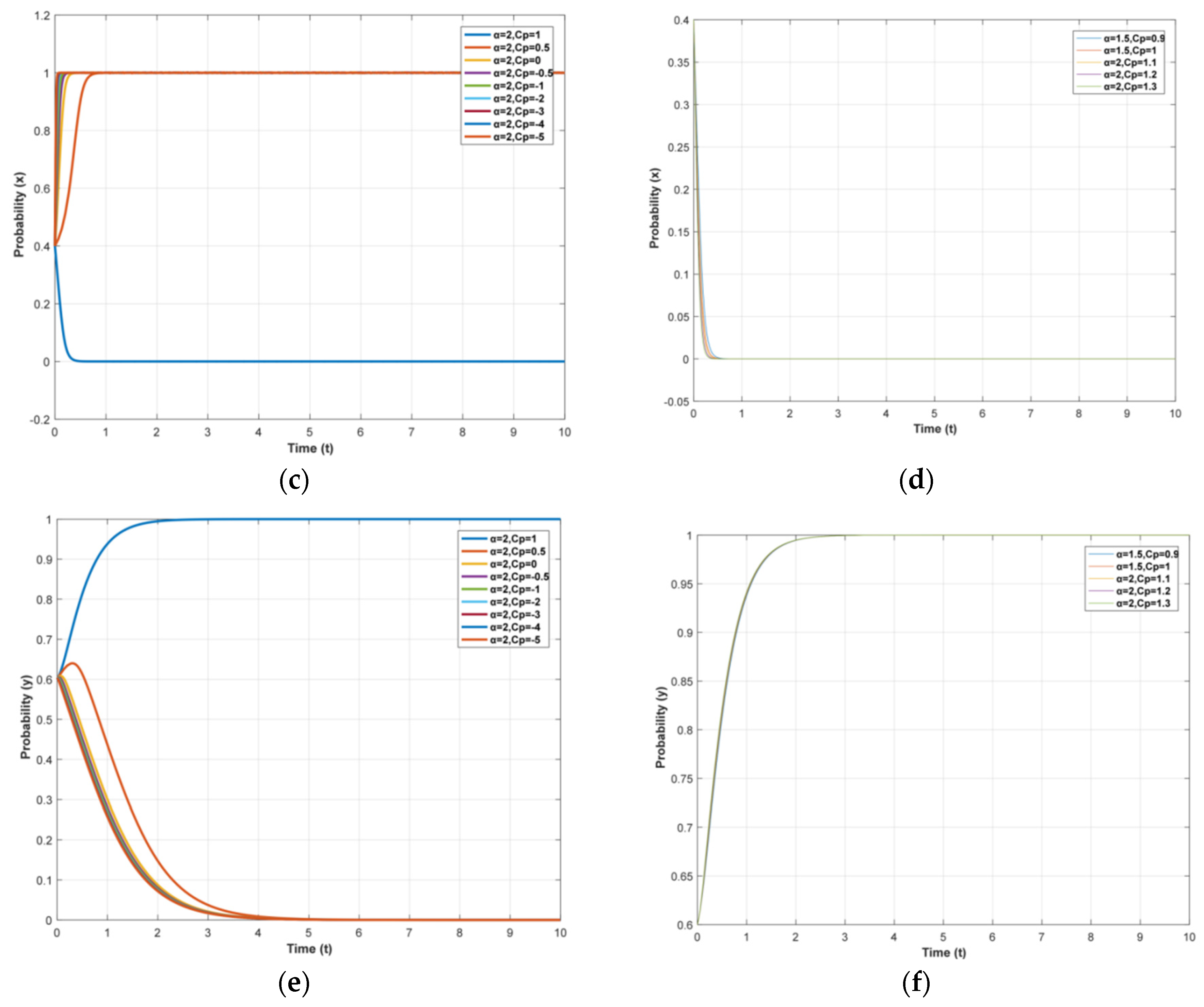
| Acronyms | |||
|---|---|---|---|
| G | Local government | E | Bike-sharing companies |
| ET | Environment tax | EPR | Extended producer responsibility |
| FPRL | First-party reverse logistics | TPRL | Third-party reverse logistics |
| x | Proportion implementing environmental tax strategy | y | Proportion implementing first-party reverse logistics strategy |
| ESS | Evolutionary stability strategy | ||
| Parameters | |||
| (a) Local government | |||
| CG | Local government regulatory costs | γ | Environmental tax rate |
| η | Coefficient of local government performance on rewards and punishments of bike-sharing companies | T | Political performance of local government from resident satisfaction: T = δCP |
| θ | Recycling subsidy coefficients under EPR system | ||
| (b) Bike-sharing company | |||
| CE0 | Unit production costs of bikes | CE2 | Third-party reverse logistics costs |
| CE1 | First-party reverse logistics costs for bike-sharing companies | CE3 | Government recycling and disposal fees for abandoned bikes under environmental tax policy |
| RE | Unit revenue from bike-sharing rentals | β | Damage rate of bike |
| ε | Transformational benefits of recycling and disposal for bike-sharing companies | ||
| Bike-Sharing Companies | |||
|---|---|---|---|
| FPRL (y) | TPRL (1 − y) | ||
| Local governments | ET (x) | δCP + γCE0 + CE3 − ηδCP − CG, RE + ηδCP − γCE0 − CE0 − CE1 − CE3 | δCP + γCE0 − ηδCP − CG, RE + ηδCP − γCE0 − CE0 − CE2 |
| EPR (1 − x) | δCP − ηδCP − CG − θε, RE + ηδCP + ε+θε − CE0 − CE1 | δCP − ηδCP − CG − θε, RE + ηδCP + ε+θε − CE0 − CE2 | |
| Parameter | Initial Value | Unit |
|---|---|---|
| CG | 0.8 | CNY |
| CE0 | 600 | CNY |
| CE1 | 1.40 | CNY |
| CE2 | 3.90 | CNY |
| CE3 | 4.00 | CNY |
| RE | 1.65 | CNY |
| β | 33.23 | % |
| δ | 1.04 | % |
| ε | 9.97 | CNY |
| γ | 0.5 | CNY |
| η | 17.59 | — |
| x | 0.4 | |
| y | 0.6 |
Disclaimer/Publisher’s Note: The statements, opinions and data contained in all publications are solely those of the individual author(s) and contributor(s) and not of MDPI and/or the editor(s). MDPI and/or the editor(s) disclaim responsibility for any injury to people or property resulting from any ideas, methods, instructions or products referred to in the content. |
© 2023 by the authors. Licensee MDPI, Basel, Switzerland. This article is an open access article distributed under the terms and conditions of the Creative Commons Attribution (CC BY) license (https://creativecommons.org/licenses/by/4.0/).
Share and Cite
Liu, L.; Liu, Z.; Yang, Y.; Shi, B.; Liu, X. Evolutionary Game Analysis of Abandoned-Bike-Sharing Recycling: Impact of Recycling Subsidy Policy. Sustainability 2023, 15, 8834. https://doi.org/10.3390/su15118834
Liu L, Liu Z, Yang Y, Shi B, Liu X. Evolutionary Game Analysis of Abandoned-Bike-Sharing Recycling: Impact of Recycling Subsidy Policy. Sustainability. 2023; 15(11):8834. https://doi.org/10.3390/su15118834
Chicago/Turabian StyleLiu, Limei, Zhe Liu, Yi Yang, Biao Shi, and Xingbao Liu. 2023. "Evolutionary Game Analysis of Abandoned-Bike-Sharing Recycling: Impact of Recycling Subsidy Policy" Sustainability 15, no. 11: 8834. https://doi.org/10.3390/su15118834
APA StyleLiu, L., Liu, Z., Yang, Y., Shi, B., & Liu, X. (2023). Evolutionary Game Analysis of Abandoned-Bike-Sharing Recycling: Impact of Recycling Subsidy Policy. Sustainability, 15(11), 8834. https://doi.org/10.3390/su15118834






